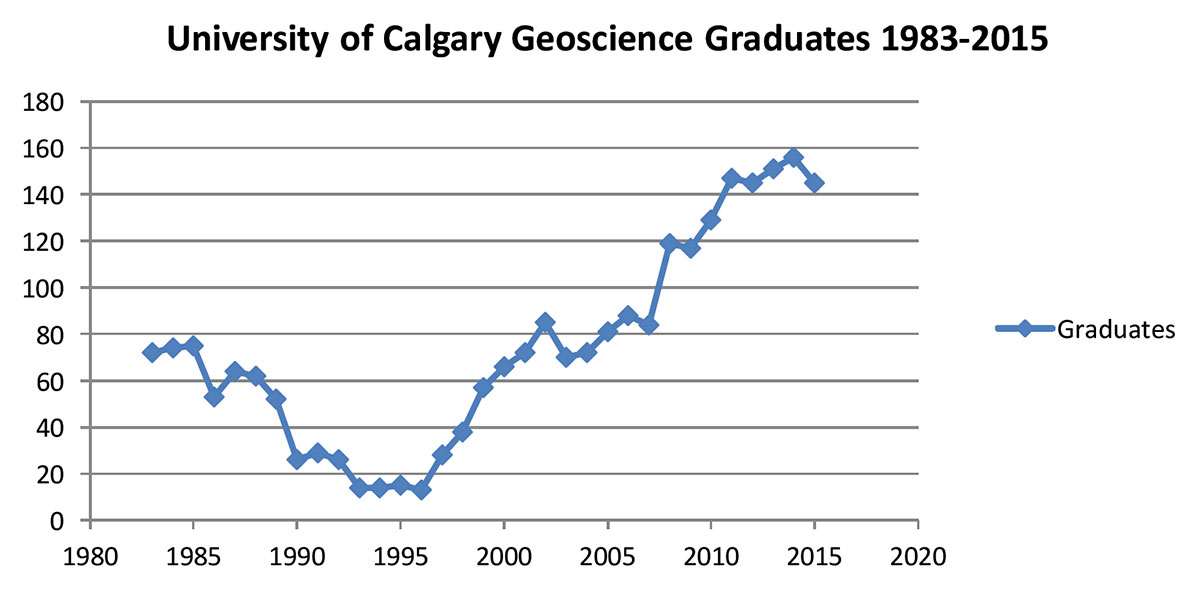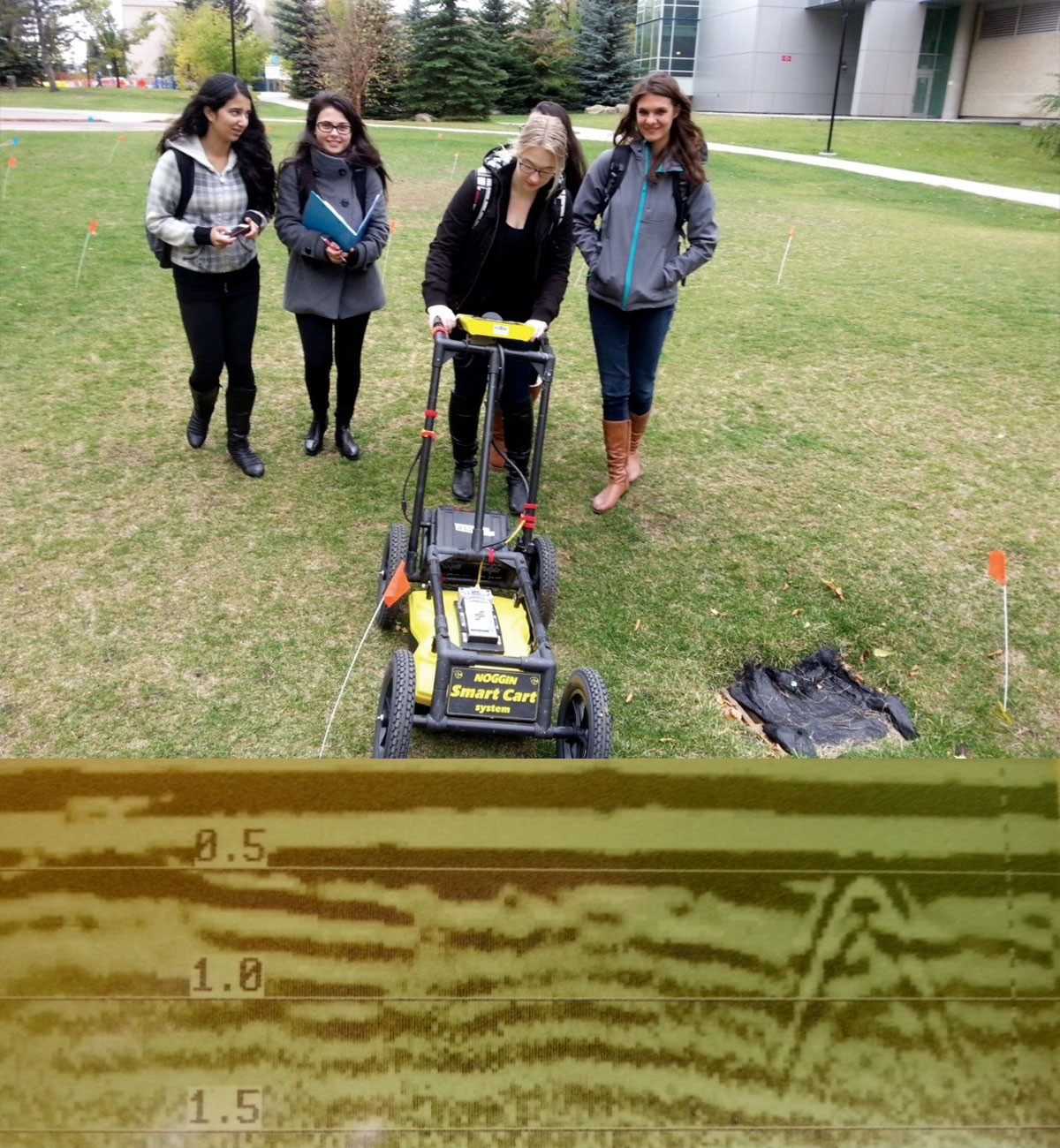The following article is based on a talk that I gave to a group of geoscientists at the 2017 Geoconvention in Calgary, Alberta. It included a series of observations that I have made regarding the state of applied geoscience at Canadian universities. While the talk was apparently not controversial nor surprising to the Geoconvention audience, it would be interesting to gauge reaction from academic administrators. It would also be interesting to receive comments from our colleagues at American universities to see if there are similarities with trends in geoscience programs in the United States.
Technical challenges in geoscience
There have been many changes in exploration and production geoscience in the past decade, with a shift to increased integration of geology, geophysics and petroleum reservoir engineering in the field of reservoir characterization. There has been an increased emphasis on reservoir development in unconventional oil fields such as heavy oil and tight oil/ gas fields. With these developments, there has been a trend toward the integration of geomodels and reservoir simulator models. In addition to the use of time-lapse 3-D seismic (i.e. 4-D seismic)in reservoir characterization, there is increased use of microseismic monitoring of the reservoir during production. Microseismic monitoring is essentially an innovative application of earthquake seismology - including the application of moment tensor solutions to determine fracture geometry, as implemented by seismologists such as Peter Duncan and his colleagues.
While the original Geoconvention 2017 talk was entitled “exploration geoscience in academia”, the present article discusses “applied geoscience” in order to include other disciplines such as environmental geoscience, which includes the analysis of water and water supplies. Environmental geoscience should provide increased opportunities for geoscientists graduating from Canadian universities while addressing crucial societal challenges.
In this discussion, geoscience includes geology, geophysics, geochemistry, hydrogeology, and general Earth science studies of energy and the environment.
Situation for energy industry professionals
While there will be new developments and opportunities for future geoscientists, major changes in the energy industry have created turbulence and distress among young professionals. There have been dramatic changes that have occurred in recent years in the petroleum industry. The petroleum market has an inelastic demand curve, meaning that purchasing of petroleum products does not vary greatly with price; however, price is very vulnerable to changing supply. Petroleum producers are “price takers” without long term delays in sales of oil and gas. Increased supply from unconventional production has caused dramatic decreases in oil prices since the heady days of $100/bbl oil prior to the fall (autumn) of 2014. Since that literal “fall”, prices have generally settled into the $30-65 range during the past three years. The slow recovery of prices has led to massive layoffs of oil industry professionals since 2015. Currently, there are few job prospects in the oil industry compared to earlier times in the last decade. During the most recent “boom period”, university enrollments in undergraduate and graduate geoscience programs burgeoned to record levels until 2016. While university enrollments correlate with oil prices, there is always a phase lag between enrollments and oil prices. Students already in the program will continue until graduation, and there is a time delay between price levels and decisions to enroll in a program.
The characterization of unconventional reservoirs and the advent of environmental geosciences offer some relief in employment opportunities. This leads to a number of questions. What are good near-term strategies for geoscience graduates? What does the future have in store for energy industry professionals? What does the future hold for geoscience university graduates in the years to come? In answering these questions, it is instructive to look at the supply of geoscience graduates.
The trend of geoscience graduates at the University of Calgary has seen record levels of graduates with steadily increasing numbers from 1994-2015 as shown in the following graph provided by Dr. David Pattison of the University of Calgary. Geoscience graduates include graduates in geology, geophysics, environmental geoscience and natural sciences (earth science).

There has been a large quantity of students graduating at the present time. The key question arises as to whether there can be simultaneous quantity and quality education at the same time. What are the tradeoffs? What are the costs of “massification” in education?
Recent enrollments in geoscience programs
There has been one definite effect due to the decreased price of oil, and that is the large reduction in first year geoscience enrollments in Fall 2016 where there was a marked decrease to about 50 students, or about 1/3 of recent levels of first year entrees.
In terms of current job prospects for graduates there is the demographic factor. Offsetting the supply of new graduates is the impending “crew change” due to the anticipated retirement of Baby Boomers. So far, these retirements have not occurred at the rate that was originally anticipated.
In addition to the concern over the optimization of student enrollment to balance quality and quantity and reach reasonable student/instructor ratios, there are some challenges for Canadian universities that offer geoscience programs. First of all, will university budgets be used for improving geoscience studies at universities?
There are certainly costs to geoscience education, in addition to faculty salary costs. There is the cost of equipments. Figure 2 shows the use of ground penetrating radar (GPR) in a physics lab at the University of Calgary. This GPR equipment costs about $35,000. Seismic acquisition systems, gravimeters and magnetometers are not cheap. Will departmental budgets continue to support the purchase of modern geophysical equipment?

Trends in Canadian university administrations and “Political Correctness”
It is interesting to evaluate costs at Canadian universities and notice that administrative costs and staffing have grown faster than any other sector of the non-academic portion of Canadian university budgets during recent decades. Data from an article by Usher (2013) on “Higher Education Strategy “(www.higheredstrategy.com) show disconcerting administrative budget trends for the 1992-2011 period. Usher’s data showed that administrative costs were less than 25% of the non-academic budget in 1992 but increased to almost 40% in 2011. Administrative staff increases have shown similar increases. We see growing numbers of administrative positions and those employed in faculty administrative offices.
There is also the “corporatization” of universities as discussed by Berg and Seeber (2016) in their book “The Slow Professor – Challenging the Culture of Speed in the Academy”. According to this book, “corporatization” of universities has led to increased stress, less time for fundamental research, busy bureaucratic tasks, increased bureaucracy, less collaboration and collegiality among academic straff, a frantic pace of contemporary university life, a massification of education, and suppression of free speech. The free speech suppression is evidenced by the fact that Israeli leader, Benjamin Netanyahu, was not allowed to speak at Concordia University in 2002 since some individuals disagreed with what he had to say about Israeli policies. Since then, other “politically incorrect” speakers have been silenced. These are problems that go beyond geoscience programs in Canada.
What can be done by the universities?
Finally, let us focus on the future of geoscience professions in the present day. Due to lower oil prices, many of the advanced geoscience technologies are in trouble. What is to be done to benefit geoscience and geoscientists? How can universities help in geoscience education?
There are some near-term strategies. Students can pursue graduate studies in order to enhance skills for eventual employability, while “buying time” and having some monetary support. The M.Sc. and Ph.D. degrees are increasingly viewed as assets by industry. Employees with a graduate degree are now preferred by employers.
International ventures should widen the spectrum of opportunities by countries seeking to hire geoscientists. Geoscientists compete in a global marketplace and Canadian university geoscience education is prioritized and supported by multinational energy companies. There is a large cohort of international students in Canadian graduate programs in geoscience. Canada is still a desirable location for education in geology, geophysics and petroleum engineering.
The field of reservoir characterization and the integration of geoscience and engineering allows for collaborative and synergistic development of Earth resources. Geoscience linked to other fields such as business, economics, education and law may allow for enhanced opportunities.
One field that is now attracting geophysicists is the field of medical imaging. This field has many similarities with geophysical imaging. The application of geophysical imaging may allow students to extend their skills to medicine where there is an increased demand. In a recent communication, Sven Treitel proposes a joint education for “imaging engineers” in geophysics and medicine. The synergies in combining expertise in both fields should prove extremely valuable. Cross-fertilization of imaging ideas can only prove beneficial.
Conclusions and suggestions for the future
The energy industries, and the petroleum industry in particular, have always seen boom and bust cycles, with concomitant changes in the employment of geoscientists. At the same time, geoscience education has generally involved learning in a wide spectrum of the sciences including geology, geophysics, geochemistry, mathematics, petroleum reservoir engineering, biology and computer science. This diversity of education should allow the geoscience graduate greater flexibility and adaptability to pursue career opportunities not only in the energy industry, but in environmental sciences, engineering, medicine, economics, education and law. It is a demanding challenge to widen our spectrum but with the attraction of many of the brightest and most energetic students into our program, geoscience at Canadian universities will continue to be in demand.

Acknowledgements
The author wishes to thank Sven Treitel for his comments on this article. Sven has been a wonderful mentor to many of us and always had prescient wisdom about the future of geoscience.










Join the Conversation
Interested in starting, or contributing to a conversation about an article or issue of the RECORDER? Join our CSEG LinkedIn Group.
Share This Article